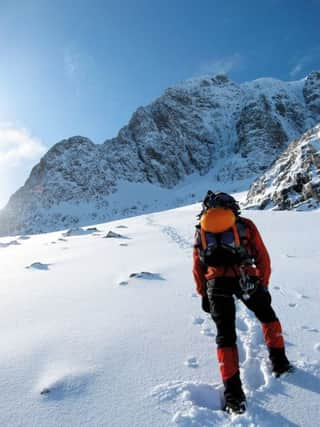Roger Cox: Deaths on Ben Nevis should give climbers pause to reflect


The name has changed since then, but I’ve always thought of it as a cyclical thing, with its own natural rhythms: just as the changing seasons tend to dictate what activities can be enjoyed in Scotland’s immense natural playground, so this slot has always tried to reflect what people are up to at different times of the year. Beyond this general shift in emphasis from season to season, however, I’ve also come to find that some of the same specific issues and debates crop up again and again, often on an annual basis, and one of the most reliable of these hardy perennials is the question of winter mountain safety.
What often happens around about now is as follows. First, the catalyst: somebody is killed or seriously injured while either walking, climbing or off-piste skiing in the Scottish mountains. Second, the knee-jerk reaction: a first wave of media commentators will, while politely stopping short of calling the judgement of the deceased into question, bemoan the fact that people seem to die in this way every year, and call for Something To Be Done, perhaps better education about the risks involved, perhaps “tighter regulation” of access to the mountains in winter. Third, the response from mountain users: spokespeople from mountaineering bodies will issue statements about how regulating access to the mountains would be a violation of the right to roam (and, by the way, impossible to enforce), while a second wave of media commentators – usually the ones who actually have some actual experience of mountains – will quote statistics that show how much safer it is to go climbing or backcountry skiing in January than it is to, for example, drive a car along the A9.
Advertisement
Hide AdI write this following a week in which a climber was killed on Creag Meagaidh, two hillwalkers died in the Southern Uplands and a young couple disappeared while climbing on Ben Nevis. As a long-serving member of the second wave of media commentators identified above, this would usually be my cue to start researching up-to-date road traffic accident stats and dusting down clichés about people dying doing what they love. This year though, for the first time, I’m starting to wonder if I might be getting it wrong. That’s not to say that I think the people on the other side of the debate are necessarily right – regulating access to the mountains in winter always has been and will always be an almighty red herring. But I think perhaps the outdoors industry – and particularly the outdoors media – might benefit from using tragedies like these as opportunities for reflection, rather than simply closing ranks and hitting back at their critics (although this is still necessary too). Because let’s be honest: nothing sells a nice new ski jacket quite like a picture of a skier launching himself off a cliff while wearing one, or outrunning an avalanche in the wilds of Alaska. In the outdoors biz, it’s not sex that shifts units so much as the faint whiff of mortality. What percentage of ads in ski or snowboard mags depict happy families cruising safe blue runs? How many climbing brands can you think of that run ad campaigns featuring athletes solving low-level bouldering puzzles over clearly-visible crash pads (not including the companies that actually manufacture the crash pads)?
Are the journalists who write about this stuff complicit, consciously or otherwise? Of course we are. I look back at some of the things I’ve written over the years and shudder. When reporting on Edinburgh climber Robbie Phillips’s very successful Alpine adventure last summer, for example, did I massively over-emphasise his one near-death experience? Yes: I spent more than three-quarters of my allotted space talking about how he and his climbing partner were nearly crushed by a falling boulder “the size of a mini,” but the bit where they eventually made it to the top of the Eiger without incident barely merited a footnote.
Is the outdoors industry to blame for the recent spate of tragedies in Scotland? Of course not – people were drawn to the mountains long before there was any money involved. But could the outdoors industry benefit from stopping to think about whether the way it represents risk is as responsible as it could be? It certainly wouldn’t do anyone any harm.